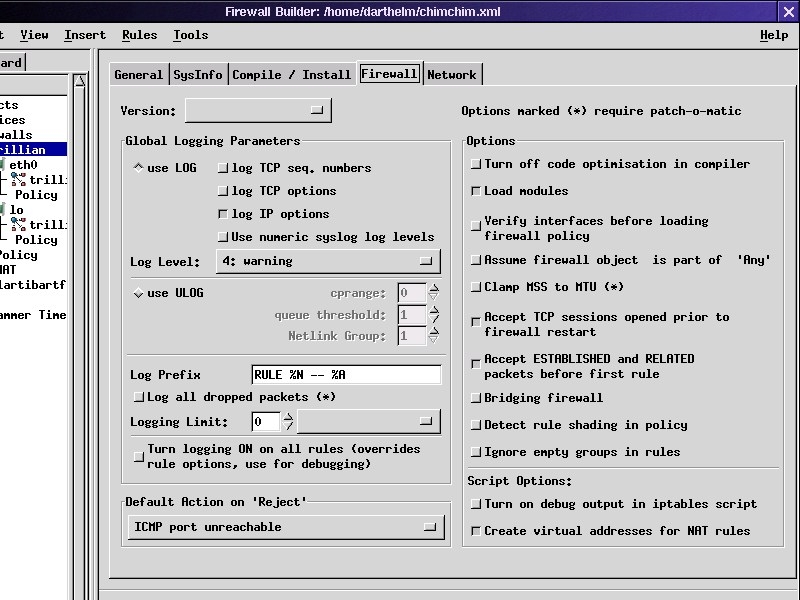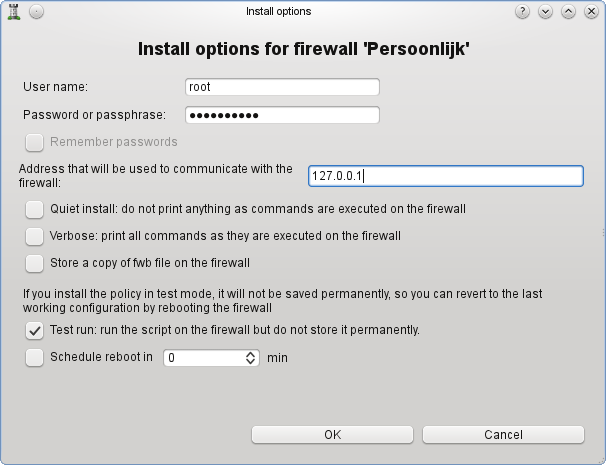
- #FIREWALL BUILDER FOR LINUX INSTALL#
- #FIREWALL BUILDER FOR LINUX FULL#
- #FIREWALL BUILDER FOR LINUX WINDOWS#
Developer community : Linux firewall solutions have an open-source bedrock, so a larger community is always helpful.GUI interface, simple command-line controls, and remote web portals are some factors to consider. Linux’s pre-built firewall solutions are extremely competent, so a big reason for installing an additional firewall is the user experience and convenience it provides. Ease of use : Depending on your technical expertise, you need a solution that marries rich functionality with ease of use.Some key features to look for in a Linux firewall solution are: A good rule of thumb is to use the first one for solo deployments, while the latter is more suited to enterprise use cases.Īlso Read: What Is a Firewall? Definition, Key Components, and Best Practices Key Must-Have Features for Linux Firewall Solutions These solutions usually include network management capabilities like traffic routing or monitoring reports to enable a 360-degree network management landscape.īoth types of Linux firewall solutions can coexist in the same organization.
#FIREWALL BUILDER FOR LINUX INSTALL#
They come within a secure, hardened OS that you can install in a shell of your choice – a bare metal appliance, a public cloud environment, or a private, virtualized shell. These are comprehensive firewall solutions (services and the configuration interface) that exist independent of Netfilter, iptables, etc. The utility lets you configure these zones further, set up custom zones, and enforce more granular policies as per your needs. The pre-built firewall will already impose some default firewall zones, like a trusted zone, a demilitarized zone, or a block zone.
#FIREWALL BUILDER FOR LINUX FULL#
You could configure these manually or install an additional utility that reveals the service’s full functionalities, simplified configurations and enables point-and-click setup. Linux firewall utilities sit on top of pre-built firewall services such as Netfilter, UFW, FirewallD, iptables, etc. Therefore, you can have two types of Linux firewall: 1.
#FIREWALL BUILDER FOR LINUX WINDOWS#
Most Linux distributions, including Debian, Ubuntu, CentOS, etc., ship with pre-built firewall services of their own (much like Microsoft Windows has Windows Defender firewall turned on by default). Top 10 Linux Firewall Solutions in 2021Ī Linux firewall is a solution or service that regulates, protects, and blocks network traffic as it passes to and from a Linux-based environment.Key Must-have Features for Linux Firewalls.Let’s understand the basics of a Linux firewall and look at the best products in the market in 2021. Given that nearly 75% of the world’s servers run on Linux, these solutions are essential to provide secure access to users and end customers. That's all! dom0 is now properly firewalled, and you should now firewall each VM as an independent entity, applying iptables rules inside the VM.A Linux firewall is defined as a solution or service that regulates, protects, and blocks network traffic as it passes to and from a Linux-based environment. This prolog should be set to run after policy reset. $IPTABLES -A FORWARD -m physdev -physdev-in vif+ -physdev-out vif+ -j ACCEPT

$IPTABLES -A FORWARD -m physdev -physdev-in vif+ -physdev-out peth+ -j ACCEPT $IPTABLES -A FORWARD -m physdev -physdev-in peth+ -physdev-out vif+ -j ACCEPT Actually, it's enough to add these two lines as a prolog: The difficult part was to get the third and fourth point into place, and it's not hard. Then, configure individual firewalls for each virtual machine.allow connections going to the dom0 interfaces for "permitted" services.forward all connections going out from a vif interface, wherever they want to go.forward all connections entering the machine from an external interface and wishing to go to a vif interface.So, the final plan formed with this shape: But I felt like that it was not the solution I was looking for. Rebuilding the standard set of Xen rules is easy indeed, and the few shell script lines could easily fit an epilog script in fwbuilder. I tested some different possible solutions and also asked for advice on the fwbuilder-discussion list. To make the firewall work properly I needed to mark it as a bridging firewall in fwbuilder then, I needed it to and have it to deal properly with the iptables' physdev module. … Xen mediates the connections to the virtual machines using bridging. It took me some time, experiments and advice to get it right, and here's how.

Summing up everything, the final plan was to install a firewall on dom0, which should a) forward to the VM the packets originating outside and directed to them (and back), and b) protect the dom0 itself. Xen itself adds forwarding rules when starting a virtual machines, and these rules are wiped away when fwbuilder scripts install theirs, which is unfortunate. It's a kind of a problem to manage a firewall for a Xen dom0 with firewall builder. Updated: April 4th, 2011 (missing rule in prolog)


 0 kommentar(er)
0 kommentar(er)
